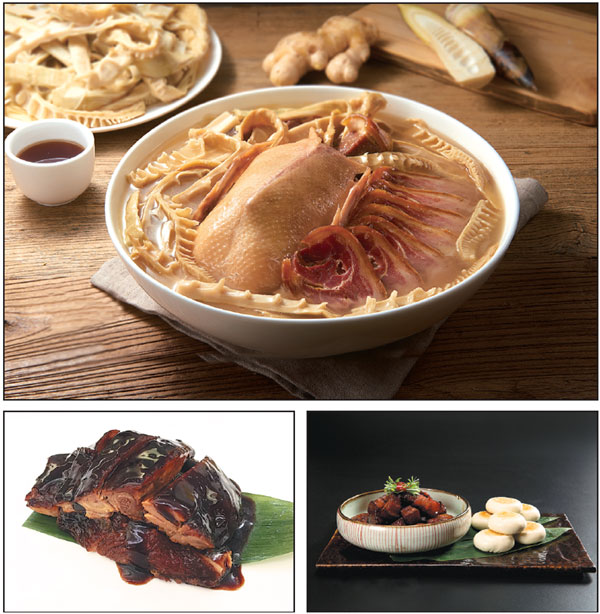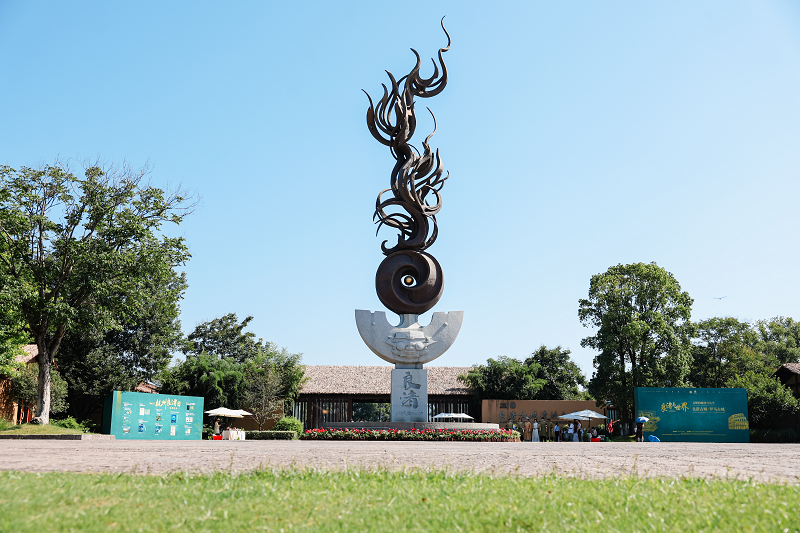Hangzhou spiced duck
Not every duck in China's capital is a Peking duck.
The one we've just ordered at Zhangshengji, the Hangzhou representative restaurant in Beijing, arrives sliced and carefully stacked in a mound on the plate. The blanket of sauce looks made for Texas barbecue, but it's surprisingly on the sweet side. The meat itself is spicy, a nice contrast to the rich sauce, and easy to handle with chopsticks even though the bones are still intact.

Clockwise from top: Old duck pot, pork braised in brown sauce and Hangzhou spiced duck are among the signature dishes of Zhangshengji. Photos by Mike Peters and Provided to China Daily
Zhangshengji is a restaurant group launched in Hangzhou in 1988, with branches today in Shanghai, Nanjing, Suzhou and Hong Kong as well as Beijing.
While Hangzhou spiced duck is a signature dish of the region, it can vary somewhat in Hangzhou itself: A more home-style version in a local canteen was spicier and not saucy but equally delicious - we had the pleasure of devouring a steel bowl full of it.
On menus, the bird is often referred to as "old duck", which probably sounds august in Chinese but lacks magic in English. There's nothing tough about this 1-year-old female green-head duck, which the Zhangshengji menu describes as "mature and healthy" and salted with soy sauce to give the duck the rich red color of Chinese dates (jujubes) and a savory fragrance. "Old duck" is cited in an ancient Chinese medical texts as a natural invigorant for humans that can cleanse the body off toxins and aid digestion. The restaurant says its chefs have invented various kinds of new dishes according to the scientific principle that "food and medicine have the same origin" based on ancient secret recipes.
Tradition is almost tangible at Zhangshengji, which serves up the classics in a white-tableclothed dining room and 10 private rooms for parties and business banquets. The diners tend to be Chinese and on the experienced side of age 40. The chatter and the clatter of platters is lively in the main dining area. There is not going to be a charger plug for your cellphone near the table.
Folks eating here have come for the food and to chat with friends and family in person. Zhejiang cuisine - one of China's eight classic styles of cooking - is famously delicate and light. Most dishes are simply and unpretentiously presented on white china that's a little shopworn, but the food never disappoints.
The showstopper on the menu may be a house specialty: sliced ham with honey sauce and buns. Refined from a private recipe of a big Shanghai family in the 1930s, the Jinhua ham with "superfine fat" gleams in the sweet sauce in which it has been simmered. The meat's texture may surprise at the first bite: It's nearly as firm as dried meat, except it's cut so thickly that it still has plenty of spring and it's easy to chew. The plate arrives at table pretty as a picture, the ham slices ringed with chunks of pumpkin and lotus seeds.
Another dish that beautifully evokes the region is stir-fried shelled shrimp with the famous Longjing (dragon-well) green tea. Like many Chinese dishes, there's a charming story behind it: The Qing Dynasty (1644-1911) emperor Qian Long was famous for visiting his people incognito, but when he presented a waiter in Hangzhou city some premium dragon-well tea to prepare for him, the waiter guessed his identity - and became so nervous that he spilled the tea onto the emperor's plate of river shrimp. The result was proclaimed to be delicious, and since then the dish has become a famous local favorite. At Zhangshengji, the platter is garnished with tea leaves, and a generous, shareable serving runs 198 yuan.
You can also try an individual serving of Dong Po Pork, said to be the creation of an ancient Chinese poet, who stewed the meat for a long time in a tiny amount of water to make the meat tender and fat but not oily. Other Hangzhou staples on the menu include duck soup with bamboo and ham, dried fish in wine sauce, braised pork with abalone in soy sauce, sweet-and-sour Mandarin fish, and a succulent pair of crispy pigeons in lifelike poses on the platter.
An intriguing specialty of this restaurant is vegetarian abalone, which we saved to try on our next visit.
We finish our meal with a tasty traditional snack, fried spring rolls with flour stick and green onion filling - which have been fried in big iron pans in Zhejiang province since the Song Dynasty (960-1279).



